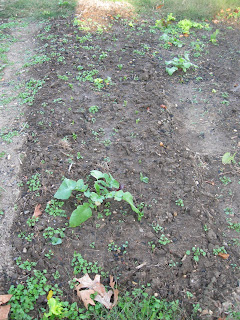





The last row of the garden is taken up by free range lettuces that have self seeded this fall and some wild onions. The lettuces look to be Grand Rapids with its chartreuse leaves and Cimmaron a red romaine. I am going to leave the lettuces and onions where they lie and fill in the bed with a handful of Bloomsdale spinach seeds that I'm pre-sprouting. Let's see how they handle hard freezes and whether they will overwinter.
My soil is predominately good old western Kentucky clay which tends to form a hard crust when dry so it is best to plant the seeds shallow then what is recommended. Amending the soil has helped the clay structure with the addition of organic matter such as leaf mold, grass clippings, rotted manure, and wood ash. This is only my third year gardening in this soil and climate so there is still some experimenting with vegetable varieties and the timing of planting out seeds and plants.





















